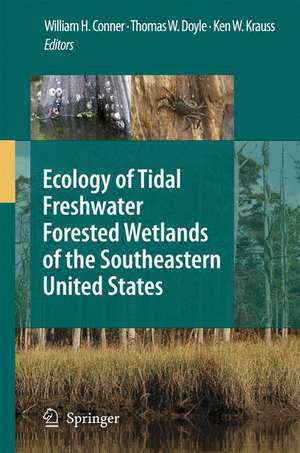Ecology of Tidal Freshwater Forested Wetlands of the Southeastern United States
Editat de William H. Conner, Thomas W. Doyle, Ken W. Kraussen Limba Engleză Hardback – 27 iun 2007
| Toate formatele și edițiile | Preț | Express |
|---|---|---|
| Paperback (1) | 1227.36 lei 6-8 săpt. | |
| SPRINGER NETHERLANDS – 19 oct 2010 | 1227.36 lei 6-8 săpt. | |
| Hardback (1) | 1236.19 lei 6-8 săpt. | |
| SPRINGER NETHERLANDS – 27 iun 2007 | 1236.19 lei 6-8 săpt. |
Preț: 1236.19 lei
Preț vechi: 1507.55 lei
-18% Nou
Puncte Express: 1854
Preț estimativ în valută:
236.59€ • 246.34$ • 199.94£
236.59€ • 246.34$ • 199.94£
Carte tipărită la comandă
Livrare economică 10-24 martie
Preluare comenzi: 021 569.72.76
Specificații
ISBN-13: 9781402050947
ISBN-10: 1402050941
Pagini: 520
Ilustrații: XIV, 505 p.
Dimensiuni: 155 x 235 x 27 mm
Greutate: 0.98 kg
Ediția:2007
Editura: SPRINGER NETHERLANDS
Colecția Springer
Locul publicării:Dordrecht, Netherlands
ISBN-10: 1402050941
Pagini: 520
Ilustrații: XIV, 505 p.
Dimensiuni: 155 x 235 x 27 mm
Greutate: 0.98 kg
Ediția:2007
Editura: SPRINGER NETHERLANDS
Colecția Springer
Locul publicării:Dordrecht, Netherlands
Public țintă
ResearchCuprins
Tidal Freshwater Swamps of the Southeastern United States: Effects of Land Use, Hurricanes, Sea-level Rise, and Climate Change.- Hydrology of Tidal Freshwater Forested Wetlands of the Southeastern United States.- Soils and Biogeochemistry of Tidal Freshwater Forested Wetlands.- Plant Community Composition of a Tidally Influenced, Remnant Atlantic White Cedar Stand in Mississippi.- Sediment, Nutrient, and Vegetation Trends Along the Tidal, Forested Pocomoke River, Maryland.- Vegetation and Seed Bank Studies of Salt-Pulsed Swamps of the Nanticoke River, Chesapeake Bay.- Tidal Freshwater Swamps of a Lower Chesapeake Bay Subestuary.- Biological, Chemical, and Physical Characteristics of Tidal Freshwater Swamp Forests of the Lower Cape Fear River/Estuary, North Carolina.- Ecology of Tidal Freshwater Forests in Coastal Deltaic Louisiana and Northeastern South Carolina.- Ecology of the Coastal Edge of Hydric Hammocks on the Gulf Coast of Florida.- Ecological Characteristics of Tidal Freshwater Forests Along the Lower Suwannee River, Florida.- Community Composition of Select Areas of Tidal Freshwater Forest Along the Savannah River.- Ecology of the Maurepas Swamp: Effects of Salinity, Nutrients, and Insect Defoliation.- Selection for Salt Tolerance in Tidal Freshwater Swamp Species: Advances Using Baldcypress as a Model for Restoration.- Assessing the Impact of Tidal Flooding and Salinity on Long-term Growth of Baldcypress Under Changing Climate and Riverflow.- Conservation and Use of Coastal Wetland Forests in Louisiana.- Tidal Freshwater Forested Wetlands: Future Research Needs and an Overview of Restoration.
Recenzii
From the reviews:
"Tidal freshwater wetlands, upstream from saline coastal estuaries, present remarkable habitats now threatened by a variety of factors including climate change and sea level rise. The editors, along with 50 contributors … here present recent, much-needed studies of these endangered areas. … The volume offers good reviews of the current use and conservation of these forested wetlands, with ample suggestions about future research needs. … This handbook is well referenced and illustrated throughout. Summing Up: Recommended. Upper-level undergraduate through professionals/practitioners." (C. Leck, CHOICE, Vol. 45 (5), January, 2008)
"The editors of this book have successfully brought together ecologists actively engaged in research on these systems … and widely dispersed grey literature to provide a comprehensive review of research findings. … For those interested in coastal wetlands, or systems that are driven by strong hydrological fluctuations, this book will be a valuable resource." (Siobhan Fennessy, Ecology, Vol. 89 (10), 2008)
"Tidal freshwater wetlands, upstream from saline coastal estuaries, present remarkable habitats now threatened by a variety of factors including climate change and sea level rise. The editors, along with 50 contributors … here present recent, much-needed studies of these endangered areas. … The volume offers good reviews of the current use and conservation of these forested wetlands, with ample suggestions about future research needs. … This handbook is well referenced and illustrated throughout. Summing Up: Recommended. Upper-level undergraduate through professionals/practitioners." (C. Leck, CHOICE, Vol. 45 (5), January, 2008)
"The editors of this book have successfully brought together ecologists actively engaged in research on these systems … and widely dispersed grey literature to provide a comprehensive review of research findings. … For those interested in coastal wetlands, or systems that are driven by strong hydrological fluctuations, this book will be a valuable resource." (Siobhan Fennessy, Ecology, Vol. 89 (10), 2008)
Textul de pe ultima copertă
Tidal freshwater forested wetlands are unique wetland systems. Occupying low relief coastal areas which are subject to both upland runoff and tidal flooding, these systems are especially vulnerable to pressure from human development and to climate change impacts of sea-level rise and increased drought/flood frequency. Yet to date the ecological dynamics, distribution, and conservation status of these communities is poorly understood.
This book draws together the latest findings from investigators focusing on the hydrological processes, community organization, and stress physiology of freshwater, tidally influenced land-margin forests of the southeastern United States. It describes the land use history that led to the restricted distribution of these wetlands, and provides descriptions of the hydrology, soils, biogeochemistry, and physiological ecology of these systems, highlighting the similarities shared among tidal freshwater forested wetlands.
Including case studies from North Carolina, South Carolina, Georgia, Florida and Louisiana, Ecology of Tidal Freshwater Forested Wetlands of the Southeastern United States will be an important resource for researchers, natural resource managers and students interested in understanding the complex dynamics of this unique coastal ecosystem; one that has been altered by land-use history and which is now undergoing decline due to changing climate, sea-level rise and hurricanes. In particular, it provides current knowledge on those biological, geological, hydrological and physical forcing factors that may influence the possible alternatives and likely success of coastal restoration projects for these vulnerable ecosystems.
This book draws together the latest findings from investigators focusing on the hydrological processes, community organization, and stress physiology of freshwater, tidally influenced land-margin forests of the southeastern United States. It describes the land use history that led to the restricted distribution of these wetlands, and provides descriptions of the hydrology, soils, biogeochemistry, and physiological ecology of these systems, highlighting the similarities shared among tidal freshwater forested wetlands.
Including case studies from North Carolina, South Carolina, Georgia, Florida and Louisiana, Ecology of Tidal Freshwater Forested Wetlands of the Southeastern United States will be an important resource for researchers, natural resource managers and students interested in understanding the complex dynamics of this unique coastal ecosystem; one that has been altered by land-use history and which is now undergoing decline due to changing climate, sea-level rise and hurricanes. In particular, it provides current knowledge on those biological, geological, hydrological and physical forcing factors that may influence the possible alternatives and likely success of coastal restoration projects for these vulnerable ecosystems.
Caracteristici
Tidal freshwater swamps are unique wetland systems These communities are poorly understood Help land managers and scientists in understanding commonalities among these forests Forests are being impacted by rising sea level and human development














